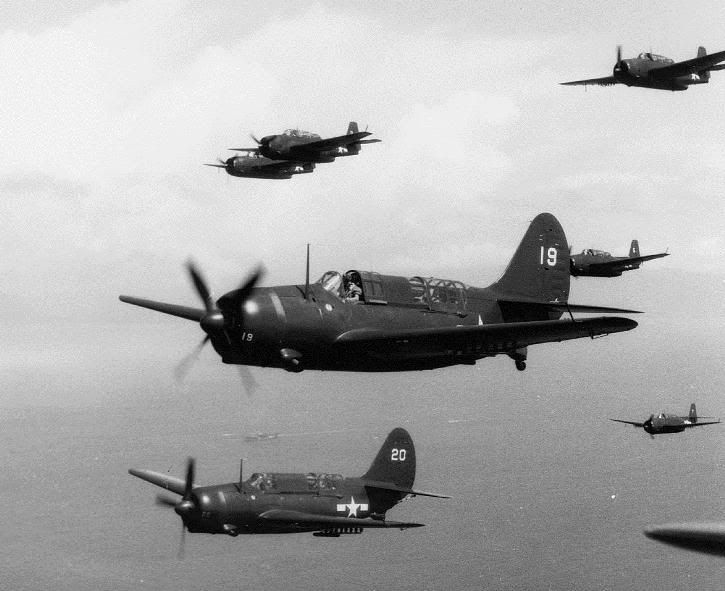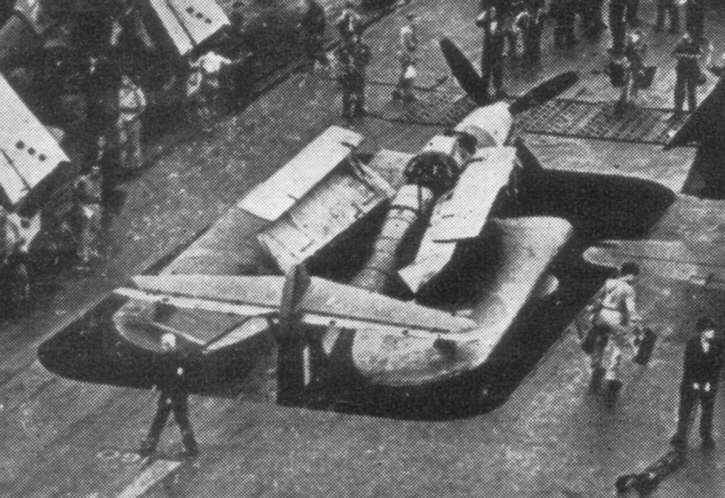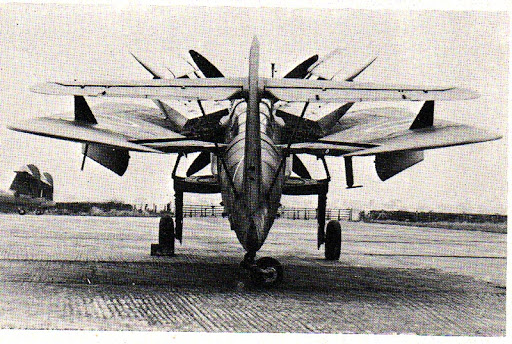This was a reply of mine to a discussion going on in the What If forum that I thought some people here might find interesting reading. I've edited some of the links and quotes to better fit here. Link to the original thread
here.
Why did the US Navy take so long to deviate away from the Dive-Bomber (B/SB), and Torpedo-Bomber (TB) and instead go straight to designs which combined dive and torpedo bombing into one earlier (1943 or 1944) instead of 1946 (The AD flew in '45 entered service next year)?
Hey everyone! Since I have been tinkering with
my fictitious Vought Viking USN dive bomber (shameless plug) for about two years now, I have read literally hundreds of pages on WWII naval strike aircraft. One of my friends at church that I have had the privilege of taking to the Naval Air Museum at Pensacola was an armorer on the
USS Hornet (CV-12) in WWII. He loaded bombs on Helldivers and Avengers in 1944 and 1945, including some of those that sunk the
Yamato. Personally, I am in no way
qualified to speak on the matter, but I have read a lot and spoken with many people who most certainly are.
Also, MOST of what I'm about to say comes from the first two chapters of
"Strike From the Sea" by Tommy Thomason. If you were interested enough in the subject of this thread to be reading this now, then you need to buy this book. I'm dead serious. Links to the author's two blogs can be found below:
U.S. Navy Aircraft HistoryTailhook Topics
Why did the US Navy take so long to deviate away from the Dive-Bomber (B/SB), and Torpedo-Bomber (TB) and instead go straight to designs which combined dive and torpedo bombing into one earlier (1943 or 1944) instead of 1946 (The AD flew in '45 entered service next year)?
Before we go about answering anything, this question in and of itself has a few misconceptions.
The first is that each of the aircraft were essentially single-role. I attribute this to the phrase "Dive-Bomber (B/SB), and Torpedo-Bomber (TB)". It should read "Scout/Bomber (SB) and Torpedo/Bomber (TB). Each aircraft type using either of these mission designations (SB2U, SBD, SB2A, SB2C, TBD, TBF, TBM) was a multi-role plane, not single-role. The SB aircraft were designed to be scouts
first and dive-bombers
second while the TBs were designed to be torpedo bombers
first and horizontal bombers
second. The Imperial Japanese Navy had basically the same division of labor, too. It was really the Royal Navy that was the odd man out (we'll come back to that later). Like most US pre-war military doctrine, this lovely idea didn't match reality, but our equipment and personnel were good enough to make up for poor doctrine,
which nobody really paid attention to anyway.
The second is the assumption that the AD Skyraider (initially designated XBT2D-1) was designed to combine the roles of the two aircraft it would eventually replace, the SB2C Helldiver and the TBF/TBM Avenger. It was not. It was designed to replace the SB2C in the scout/dive bombing role. Why the "T"? Well, it could drop a torpedo, too. Little-known fact: so could the SB2C Helldiver; it was designed to be able to carry a torpedo and was tested in that role. What you may also not know is that the Navy was running another competition at the same time as the BT program. Any guesses what those designs were designated? TB. That's right, in 1945 the US Navy was STILL shopping SEPARATELY for a dive-bomber/torpedo bomber (BTC, BT2C, BTD, BT2D, BTK, BTM) and a torpedo bomber/horizontal bomber (TB2D, TB2F, TB3F). In fact, they would have had two separate planes for those jobs in 1945 if the US Navy hadn't wisely realized that the anti-surface ship torpedo attack role was on its way out...for good.
For proof, look at the Skyraider's stablemate at Douglas, the XTB2D-1 Skypirate. If they were being designed for the same role, why would Douglas compete against...itself?

The US Navy didn't really combine the two roles; it just got rid of one altogether. It wasn't 1+1=1. It was 2-1=1. With the exception of an attack on a dam (hardly sporting) and sub-hunting, the US Navy was done with aerial torpedoes completely after 1945.
So, to answer the question, WHY did they not combine the two roles? Because they were smarter than that. I know I'm going to get flak from this but stay with me. JoeP was totally on the right track with his first statement:
Torpedo bombers don't need dive flaps or the construction needed to pull Gs out of a dive and the extra weight and complexity required.
Dive bombers, on the other hand, don't need the third crewman (bombardier) with a Norden bombsight, or the extra torpedo aiming devices and the long, large torpedo/bomb bay. The SB2C Helldiver, for example, could carry a torpedo, but not
internally like the TBF Avenger.
"Yes, I understand all that, but is that little bit of saved weight and volume really worth the extra aircraft type on a carrier?"
Well, in a word, yes.
Just do some quick and dirty Wikipedia research. The Fairey Barracuda (dive bomber/torpedo bomber), the SB2C Helldiver (dive bomber), and the Grumman Avenger (torpedo bomber) all weighed within about 1/2 ton of each other, had similar folded dimensions, similar HP, and all entered service within 6 months of each other. Can I compare the 3? Good.
The Helldiver and Avenger have similar overall performance despite their drastically different roles. Compared to the contemporary Barracuda, the US aircraft could fly about 50-70 mph faster, 400 miles further, and 13,000 feet higher. On top of all that, they had about twice the rate of climb and far better armament, too.

From Wikipedia:
"The Barracuda's performance was reduced by the high temperatures of the Pacific, with its combat radius being reduced by as much as 30%, and the torpedo bomber squadrons of the fleet carriers of the British Pacific Fleet were re-equipped with Grumman Avengers.
The Barracuda's primary problem in the Pacific was the need to fly over Indonesian mountain ranges to strike at targets on the eastern side of Java, and this necessitated a high altitude performance which the Barracuda's low altitude rated Merlin 32 engine, and its single stage supercharger, could not provide. Additionally, carrying maximum underwing bomb loads caused extra drag which further reduced performance over a torpedo equipped Barracuda."

The Royal Navy decided it was better to have an airplane that was good at a couple of roles than one that was lackluster in EVERY role. The US Navy on the other hand got two aircraft that did all the jobs asked of them quite well.
But carrying a single type provides economy of scale in spares and training. It allows you to mix your strike packages to suit the situation and mission.
In theory, yes, but in practice it's not as glorious as all that. Just because there are two different aircraft types doesn't mean you have two of everything. The Helldiver and Avenger shared the same ammunition, same bombs, same engine, etc. Your "all-in-one" type such as the Barracuda ends up being complex. Whether it's flown a single dive-bombing mission in months, you still have to maintain all of it. Just, just look at it.

It looks like a maintenance nightmare.
Check out the landing gear, too.
Finally, there's one last thing I need to address.
Everybody
In WW2, had the USN ever employed carrier aircraft against land-based targets?
Yes, absolutely. The US carrier aircraft
began attacking Japanese targets on land in large numbers on February 1st, 1942 during the Marshalls-Gilberts raids and continued to do so in earnest
until literally the moment of Japan's surrender.
I wouldn't be surprised if the US Navy dropped 100 times the tonnage of bombs on land targets that all other nations (Great Britain and Japan, primarily) combined dropped, no exaggeration.

Anyway, I hope this has been helpful!
Cheers,
Logan